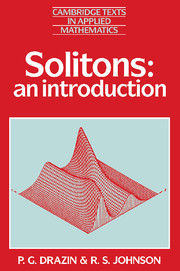Book contents
- Frontmatter
- Contents
- Preface
- 1 The Korteweg–de Vries equation
- 2 Elementary solutions of the Korteweg–de Vries equation
- 3 The scattering and inverse scattering problems
- 4 The initial-value problem for the Korteweg–de Vries equation
- 5 Further properties of the Korteweg–de Vries equation
- 6 More general inverse methods
- 7 The Painlevé property, perturbations and numerical methods
- 8 Epilogue
- Answers and hints
- Bibliography and author index
- Motion picture index
- Subject index
7 - The Painlevé property, perturbations and numerical methods
Published online by Cambridge University Press: 05 June 2012
- Frontmatter
- Contents
- Preface
- 1 The Korteweg–de Vries equation
- 2 Elementary solutions of the Korteweg–de Vries equation
- 3 The scattering and inverse scattering problems
- 4 The initial-value problem for the Korteweg–de Vries equation
- 5 Further properties of the Korteweg–de Vries equation
- 6 More general inverse methods
- 7 The Painlevé property, perturbations and numerical methods
- 8 Epilogue
- Answers and hints
- Bibliography and author index
- Motion picture index
- Subject index
Summary
This chapter is devoted to three additional topics.
The equations we have discussed have been those for which the inverse scattering transform is applicable. However, given any evolution equation, it is natural to ask whether it can be solved by the inverse scattering transform (1ST); in other words, how do we decide if a given equation is completely integrable? This question is still open but a promising conjecture concerns the so-called Painlevé property. We shall describe how the Painlevé equations arise, what they are and the conjecture itself.
If the evolution equation cannot be solved by the 1ST, but is close to one which can be (by virtue of a small parameter), we may adopt the following procedure. The 1ST method is formulated in the conventional way but the time evolution of the scattering data now involves the small parameter. This parameter can be used as the basis for generating an asymptotic solution of the inverse scattering problem, and hence of the original equation. We shall outline the development of this argument.
Finally, if neither of the above methods is applicable, or if a graphical representation of the solution is required, then we may use a numerical solution. Indeed, the original motivation for the 1ST came from a study of numerical solutions of the KdV equation. We shall, in the final section of this chapter, present some numerical methods suited to the solution of the initial-value problem for evolution equations.
Information
- Type
- Chapter
- Information
- SolitonsAn Introduction, pp. 169 - 189Publisher: Cambridge University PressPrint publication year: 1989
